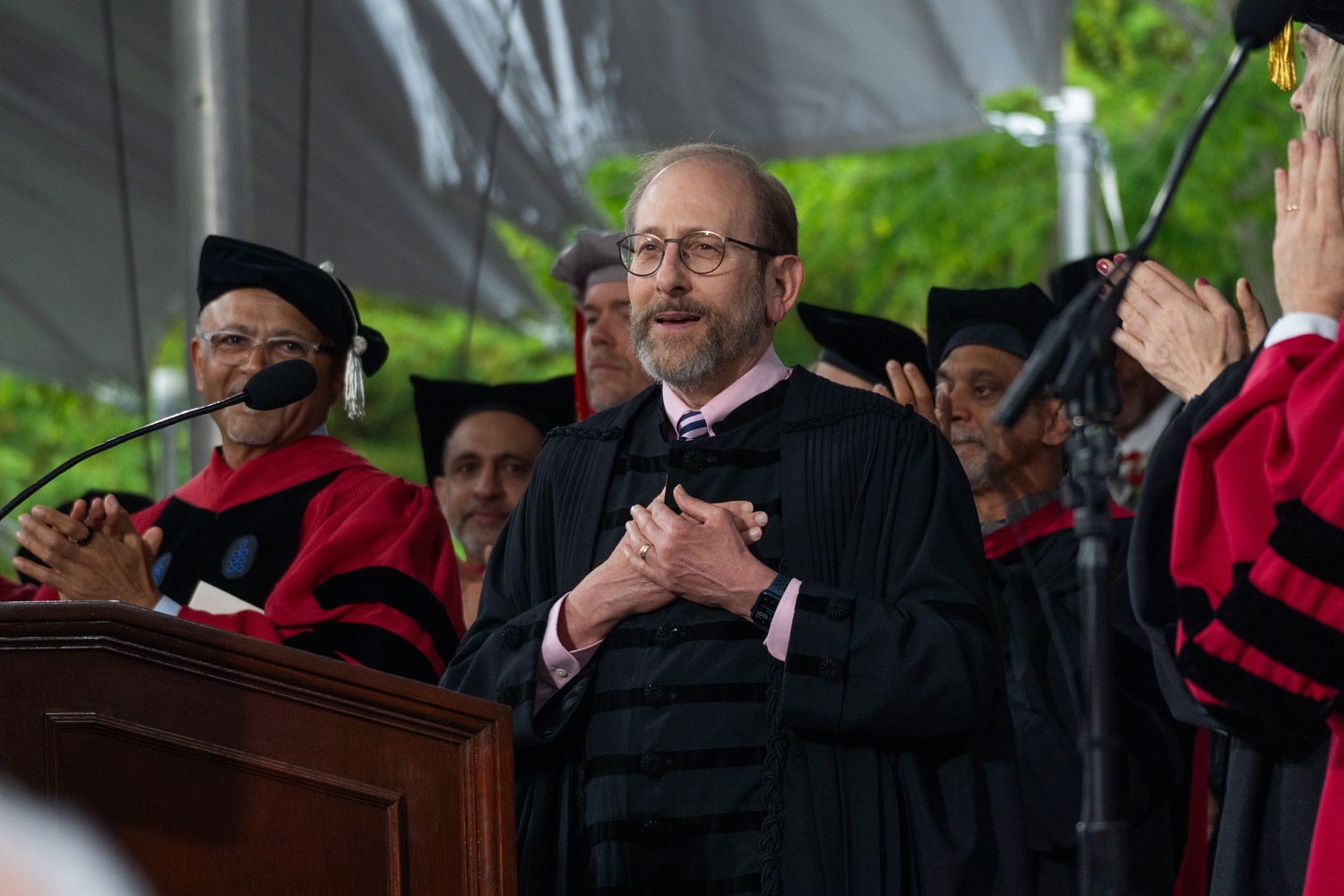Faculty of Arts and Sciences Survey Shows Strong Support for Harvard President Garber
Nearly three-quarters of respondents approved of Harvard President Alan M. Garber ’76 on The Crimson’s annual Faculty of Arts and Sciences survey as he leads Harvard’s resistance to the Trump administration. Harvard’s governing boards saw improved but still negative approval ratings.
Faculty overwhelmingly approved of Harvard President Alan M. Garber ’76 on The Crimson’s annual Faculty of Arts and Sciences survey — a ringing endorsement that arrived as Garber attempts to steer the University through the Trump administration’s onslaught.
The survey was distributed just days after Garber publicly defied the Trump administration and sued the White House for cutting Harvard’s federal funding. His defiance has positioned the University as a bastion of resistance to Donald Trump — and won him accolades from alumni, students, and higher education leaders alike.
The survey results, which found that 74 percent of respondents were “somewhat” or “very satisfied” with Garber’s tenure as president, present further evidence that Garber has the backing of a core constituency in his fight against Trump: the professoriate at Harvard’s oldest and most powerful school.
The survey also found FAS Dean Hopi E. Hoekstra has strong, though slightly narrower, support from her school’s faculty body. A 57 percent majority said they were satisfied with her leadership — a slight increase from last year, when just under half were satisfied. (The Crimson did not measure approval for Garber last year during his interim presidency.)
Though faculty backed the two administrators, a plurality said they lacked confidence in the University’s two governing boards, the Harvard Corporation and the Board of Overseers. The negative ratings were still an improvement from last year’s survey, which found widespread dissatisfaction with the two bodies after the chaotic end of Claudine Gay’s presidency.
A Harvard spokesperson did not respond to a request for comment.
The Crimson’s FAS survey was distributed to more than 1,400 faculty members, including both tenure-track and non-tenure-track faculty, with names collected from the FAS’ public masthead. Faculty were polled on demographic information, politics, and campus issues.
The email survey had 406 responses, with 260 fully completed and 146 partially completed. The survey was open for three weeks, from April 23 to May 12.
This is the second installment in a series on the survey results. The first covered faculty perspectives on Harvard’s lawsuit over federal funding cuts and Trump’s demands to the University. This piece focuses on the University’s governance.
Governance
When Garber spoke at Commencement in May 2024, he was booed by attendees for barring 13 undergraduates involved in pro-Palestine advocacy. But this year, he was met with thunderous applause for defying Trump — a vote of confidence echoed by the survey’s findings.
And his approval rating eclipses that of his recent predecessors, far outpacing FAS support for Lawrence S. Bacow at the end of his term, when The Crimson last measured faculty satisfaction with a sitting Harvard president.
The Corporation and Board of Overseers, however, did not seem to reap the rewards of Harvard’s defiant stance.
A 47 percent plurality disapproved of “the actions” of the two governing bodies, with 27 percent saying they were “somewhat dissatisfied” and 20 percent saying they were “very dissatisfied.” Just 5 percent said they were “very satisfied” and 23 percent said they were “somewhat satisfied.
The approval ratings marked a slight increase from last year’s survey, which found 33.6 percent of faculty respondents were “somewhat dissatisfied” and 29.7 were “very dissatisfied.” But the figures remain markedly lower than those for Garber and Hoekstra.
Fifty percent of respondents answered that they were “somewhat” or “very dissatisfied” with the current structure of Harvard’s governing bodies.
Faculty have long raised concerns that the Corporation is too removed from Harvard’s day-to-day operations and lacks clear communication channels to hear from professors. A 74 percent majority of respondents echoed that concern, saying the Corporation needs to be more transparent in its decision-making. Only 8 percent said they disagreed to some degree.
Most respondents think that faculty should have a seat on the Corporation — with 51 percent saying they “strongly agree” and 22 percent “somewhat agree.” A planning body tasked with designing a faculty senate said in April that they were considering whether to push for representation on the Corporation.
“There have been some senates where a senate officer actually sits on the Corporation,” University Professor Danielle S. Allen, who has spearheaded the push to create a faculty senate, told The Crimson in April. At some universities, she said, there is a “routine expectation” that a faculty senate committee attends at least one governing board meeting.
Sixty-four percent of survey respondents said they supported the creation of a faculty senate, with 40 percent saying they “strongly agree” that faculty should form a senate.
A majority of respondents also said they wanted Garber to chair faculty meetings: 38 percent answered that they “strongly agree” and 24 percent said they “somewhat agree” that he should be present. Harvard presidents chaired FAS meetings for decades, keeping open a direct line of communication between the University’s top administrator and its most powerful faculty body, but the tradition ended when Gay — a former FAS dean — decided she would stay out of the Faculty Room to empower Hoekstra, her successor.
While Garber has occasionally spoken at faculty meetings during his tenure, those sessions have been exceptions — and often conducted in camera, meaning only voting members of the FAS can attend.
Most faculty respondents said they wanted greater decision-making power in the University’s governance. Thirty-six percent of respondents said that the professoriate should have “much more” sway, while 38 percent said they should have “somewhat more” influence.
Though Garber has received glowing praise since defying the Trump administration in April, he now finds himself in a precarious position as he looks to resolve the White House’s feud with Harvard. Garber confirmed to donors last week that the University had resumed talks with the administration, and that shared concerns included antisemitism and a lack of “viewpoint diversity.”
The Trump administration’s punitive actions have cost Harvard billions of dollars in federal funding, and the University has been racked by layoffs and austerity measures, with vital research on pause. Some faculty say that striking a deal could allow Harvard to salvage its operations while taking actions on issues where it can find common ground with the White House.
But survey respondents overwhelmingly opposed the administration’s demands that Harvard audit students and faculty for “viewpoint diversity,” per The Crimson’s FAS survey, and a 63 percent majority said they disagree that there is systematic antisemitism on campus — consistent with last year’s survey.
And many professors — alongside several alumni groups — have expressed concern about any agreement with the Trump administration. The White House, they argue, can’t be trusted to hold up their side of any bargain.
“An agreement you make with this administration is not worth the paper it’s written on,” English professor Derek Miller said in an interview last week. “No matter what you sign, you can’t trust them.”
Methodology
The Crimson’s annual faculty survey for 2025 was conducted via Qualtrics, an online survey platform. The survey was open from April 23 to May 12.
A link to the anonymous survey was sent via email to 1,425 faculty in the FAS and the School of Engineering and Applied Sciences. The list comprised all faculty named on the FAS masthead for the current academic year, which also includes FAS department and standing committee affiliates whose appointments are in other Harvard schools.
In total, 406 faculty replied, with 260 filling the survey completely and 146 partially completing the survey.
To check for response bias, The Crimson compared respondents’ self-reported demographic data with publicly available data on FAS faculty demographics for the 2024-2025 academic year. (Unlike The Crimson’s survey, this data only includes faculty with FAS appointments.) The demographic data of survey respondents generally match these publicly available data.
Sixty percent of respondents said they hold a tenure or tenure-track position, according to the survey. According to the FAS Dean’s 2024 Annual Report, 56.81 percent of FAS faculty are tenured or on the tenure track.
Forty percent of respondents who identified their gender on the survey said they are female. Thirty percent of respondents who reported their race did not identify themselves as white. (Another 13 percent of respondents did not identify their gender, and 23 percent declined to identify their race).
These figures compare to 39 percent of FAS faculty who identify as women and 28.8 percent who are not white, according to the FAS Dean’s Report.
Among respondents who said they hold a tenure or tenure-track position, 34.5 percent belong to the Arts and Humanities division, 26.7 percent to the Sciences division, 32.8 percent to the Social Sciences division, and 6 percent to the School of Engineering and Applied Sciences.
That means Arts and Humanities faculty were overrepresented and SEAS faculty were underrepresented among survey respondents. According to publicly available data for the 2023-24 academic year from Harvard’s Faculty Development and Diversity Office, the most recent year for which data is available, 26.4 percent belong to the Arts and Humanities division, 27.9 percent to the Sciences division, 32.5 percent to the Social Sciences division, and 13.2 to SEAS.
The Crimson could not find public FAS data on the distribution of non-ladder faculty across the divisions.
Survey responses were not adjusted for selection bias.
—Staff writer William C. Mao can be reached at william.mao@thecrimson.com. Follow him on X @williamcmao.
—Staff writer Veronica H. Paulus can be reached at veronica.paulus@thecrimson.com. Follow her on X @VeronicaHPaulus.
